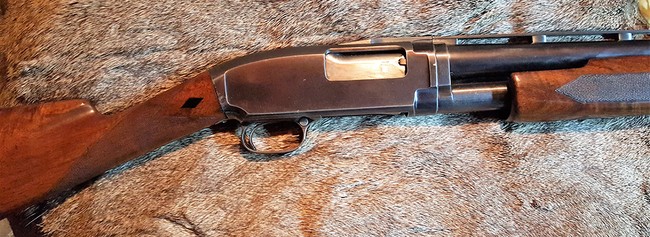It’s all well and good, of course, to discuss the technical aspects of guns, their history, and so on – but it’s also important to discuss the use of guns, how we train in their utilization, and how some of us have to learn important things about gun handling the hard way.
In the Beginning…
One of my earlier memories of shooting sports involved a story related by my uncle, who described a hunting outing taken in the late 1920s with his buddy from a neighboring farm. My uncle had just obtained an old single-barrel muzzle-loading shotgun for nothing, as he had found it under the floor of a chicken coop he had been hired to tear down.
After missing a few shots, my uncle and his buddy began to wonder if they were loading the ancient piece properly. Grandpa had advised them on how to load the piece, as he had used a few front-stuffers in his own time, but boys will be boys, and after a while began to doubt the old man’s advice.
“You know,” my uncle said, holding up the little powder measure Grandpa had made them, “if one of these is good, two or three ought to be better, right? Maybe she’ll shoot a little farther.” His buddy agreed, so they reloaded the old boom stick with a good healthy triple helping of powder.
Moments later, as they were walking down the road, a jackrabbit startled out of the ditch. My uncle raised the old gun, thumbed back the hammer, pulled the trigger…
…and as he always told the story, he woke up a few moments later in the ditch on the other side of the road, his shoulder hurting. The old gun lay in the middle of the road, and his buddy was bent over, in the middle of a huge cloud of black-powder smoke, hands over his ears. My uncle realized that his ears were ringing, and they continued to do so, as he always told it, for several days.
They stuck to loading the old gun per instructions after that.
I should have learned from that tale, but as time went on and I started messing around with various firearms myself, it became apparent that my skull was a little thicker than was good for me.
“Collectibles.”
These days I have a distinct preference for old Winchesters and Belgian Brownings. One of the centerpieces of my collection is a Winchester Model 12 Black Diamond trap gun, made in 1940, with a 32” barrel choked so tight that the pellets leave the muzzle in single file. But back in the day when I had not yet learned the difference between “collectible” and “old”, that lack of distinction led to some interesting incidents.
 And by “interesting” I mean “possibly threatening to life and limb.” Now, my friends are I were indeed fortunate to have fathers and grandfathers who taught us the basics of safe gun handling; I remember my father's favorite saying regarding shooting was that "...the only safety you should rely on is the one between your ears," which left me in better straits than some Hollywood types I could name.
And by “interesting” I mean “possibly threatening to life and limb.” Now, my friends are I were indeed fortunate to have fathers and grandfathers who taught us the basics of safe gun handling; I remember my father's favorite saying regarding shooting was that "...the only safety you should rely on is the one between your ears," which left me in better straits than some Hollywood types I could name.
See Related: 'Rust' Armorer Sentenced to 18 Months; Does Not Bode Well For Alec Baldwin
Case in point: When I was about sixteen, an acquaintance of mine who was working as a carpenter called me one summer afternoon. “We’re putting a new roof on a house down here in Calmar,” he told me, “and I found an old shotgun hidden in the rafters. I was wondering if you wanted it.”
“Sure!” I replied, not worrying myself about what kind of shotgun it was or what condition it was in – after all, what self-respecting Allamakee County teenage boy ever turned down a free gun?
It didn’t occur to me to ask why my roof-fixing buddy didn’t want it.
Overcome by curiosity, I hopped in the truck and drove to Calmar that afternoon. When I arrived at the work site, I was handed a remarkable old piece. It was a 12-gauge side-by-side double, carrying the Springfield/Stevens name, an old model that was one of the forerunners of the Stevens 511 double.
What made this one interesting was that the barrels had been hacksawed off at about twelve inches, making it not only probably unpleasant to shoot but illegal as well. I didn’t worry over much about that, though, when measuring it against a free firearm; I removed the fore-end and the barrels, stashed the illegal barrels in the toolbox, tossed the receiver and fore-end in the seat of the truck, and took off for home.
I toyed with the idea of seeking a new set of barrels to make the old gun 1) legal and b) useful, but in those pre-internet days, that meant either driving to Des Moines twice a year for gun shows, writing a lot of letters or spending some long-distance calling coin for parts companies. My early efforts were unsuccessful, so one boring Saturday night, my old pal Dave and I decided that what the hell, we’d take the old piece for a test drive.
Part of the mounting mechanism on the fore-end was broken, so we had to disassemble the old gun and use a narrow-bladed screwdriver to cock it, but with that done, we reassembled the gun. We decided to drive down to a local area down by the Cedar River known as “The Pits” to test-fire, and since the piece was something that wouldn’t have been out of place in John Dillinger’s arsenal, we hid it under the seat of the truck for the drive down.
On the edge of one big gravel pit, there was a stack of old tires. We headed there; this wasn’t our first experience with old guns. For the first two shots, we stuck the old piece in a tire and pulled the triggers with a string from about thirty feet away. There was a satisfying BOOM from both barrels, and the gun/tire skipped back about a foot on the sandy ground with each shot.
We inspected the gun. “Looks OK,” Dave opined, examining the gun in the headlights of the truck. “I think you should try shooting it.”
“I don’t know,” I said. “Probably OK just those two shots in the tire.” I hefted the piece; I couldn’t help to notice that, if shouldered, the abbreviated piece would have both muzzles uncomfortably close to my young and handsome (well, young, anyway) face – and this was in a more innocent time when we generally didn’t bother with hearing or eye protection.
The debate continued for some time, but thanks to teenage machismo, the outcome was never truly in doubt. Dave tossed an old beer can out into the light from the truck headlights, I dunked a couple of high-brass shells of uncertain origin into the old gun, shouldered it, and let fly.
WHAM! WHAM!
To call the recoil and muzzle blast unpleasant was a gross understatement. My ears rang for days, and later, at home, when I looked in the bathroom mirror, I was fairly certain there was powder stippling on my face. I ended up tossing the sawed-off barrels in the river and sold the receiver and fore-end to a gunsmith friend for twenty bucks, which in those days would have made for a pretty spectacular weekend.
That wasn’t the end of the story.
The Ditch Witch
But as it turned out, the experience gave Dave an idea. One afternoon, he showed up at the house with an old 12-gauge H&R Topper single shot. “Got it at a garage sale in town,” he told me, “for forty bucks.” I knew Dave had a reasonably new 870 Remington pump gun for hunting, so was a little curious about the Topper.
Many of us, mind you, started our careers with very similar single-shot pieces. While their simplicity made them easy to operate and prevented inexperienced kids from, as the Old Man used to put it, “going banging around,” they did have one disadvantage: their weight. Being basically a piece of pipe stuck on a minimal receiver and a stock generally made of relatively light birch or other cheap hardwood, a 12-gauge single could easily weigh less than six pounds. That lightweight made carrying easy, especially for a kid, but shooting? With high-brass hunting loads? Unpleasant, at best.
But Dave’s idea was to double down on that. We took the old Topper into the workshop and, after carefully scouting around to determine the Old Man wasn’t about to walk in on us – turned out he and Mom had gone to town – we took a hacksaw to the Topper’s barrel, cutting it off at the legal minimum of eighteen inches. We used one of Dad’s big files to smooth off the muzzle and even recovered the bead from the amputated segment, drilled and tapped a new hole, and reinstalled the sight; country kids do manage to learn all sorts of useful skills, and the Old Man kept a well-stocked tool chest. The gun itself wasn't a worry; we were, after all, of a time when it was common to see shotguns in the gun racks of pickups parked in front of the school, unlike today's increasingly hoplophobic times. But the amateur gunsmithing may have raised an eyebrow from any of the parents involved.
See Related: Nebraska Legislature Passes Law Allowing Teachers to Arm Themselves on Campus, Awaits Gov.'s Signature
Dave called it the Ditch Witch. I’m not saying we shot rabbits or pheasants out of the window of the truck – that would have been illegal - but if we would have done so, we’d have had the perfect gun for it. The Ditch Witch was manageable – just – with low-brass trap and skeet loads. We didn’t try anything else, knowing all too well what the likely result would be.
And So, This Happened…
Late-season pheasants tend to flush wild, requiring tight chokes and ammo with some reach. The last few weeks of the season generally found us stuffing our game coats with 12-gauge 3” Magnum shells with #4 shot, to give us that reach. After all, in those long-ago days of boastful youth, we operated on the principle of “if some is good, more is better” in almost all things, and that practice at times provided some harsh lessons.
While our big, heavy Remington and Mossberg pumps handled the big 3” magnums with no real trouble, Dave always packed along some light trap loads for the Ditch Witch, in deference to its weight – a tad short of five pounds. As the Ditch Witch generally traveled stuffed under a truck seat, the shells were always at hand in the glove box.
Returning one frigid December afternoon from the cornfields down around Winthrop, where we had managed to bring to bag nothing but rabbits, Dave suddenly stopped his old car along the edge of the gravel road. “Look up there,” he said, pointing. “Right side of the road. On that fence line.”
There were four big rooster pheasants, walking slowly along the fence on the side opposite the road.
Now folks that aren’t familiar with wildlife don’t always get that most critters that live in populated areas are pretty familiar with cars and trucks, generally regarding them as part of their local landscape. Still, they know that when a car or truck stops, humans generally emerge, and they know humans can be dangerous. Dave proposed to take advantage of that.
“Grab the Ditch Witch,” he suggested. “I’ll drive up there kind of slow, and when we’re just opposite them, I’ll slam on the brakes. You roll out and see if you can hit one or two of them.”
“Got it,” I replied quickly. I dug under the seat and grabbed the old pipe. And, clearly not thinking too hard about the task at hand, I reached into the pocket of my hunting coat and extracted two 12-gauge shells. It is possible to get off two shots pretty quickly with a single; the trick is to hold the second shell between the index and middle finger of your non-firing hand, and when the first shot is fired, eject, dunk in a new round, and re-commence operations.
I opened the Ditch Witch and dropped in a round. Dave idled his old Ford up the road. The roosters stopped and watched the car approaching.
I hadn’t looked at the shell I dropped in the chamber.
As we approached, the pheasants began to show signs of alarm. “Now!” Dave yelled.
I slammed the Ditch Witch closed, and rolled out the car door into the snow-filled ditch. I came up on one knee, spitting snow, and sighted on one rooster that was legging it for greener pastures. I thumbed back the hammer and pulled the trigger.
WHAM!
As the gun slammed into my shoulder with piledriver force, a little voice in the back of my head reminded me of the contents of my hunting coat’s shell loops – big, nasty three-inch Magnums stuffed with almost two ounces of copper-plated #4 shot.
The Ditch Witch recoiled sky-high. I almost lost my grip on the gun, which may have been a better result, as the little piece slammed backward – the hammer took a bite out of my cheek, and the hard plastic buttplate left a nasty bruise on my shoulder.
I sat down hard. My ears were ringing. I could dimly hear Dave’s voice, calling to me, sounding like he was at the bottom of a rain barrel: “Are you OK? You idiot, did you use one of your magnum rounds?”
I shook my head. The rooster lay a short distance away. I got up, staggered over to it; the bird was damn near shot from between its wings. It had only been about twenty feet away. What was left was inedible. We left it there for the foxes.
After a couple of missteps caused by what was likely a low-order concussion, I managed to get back in Dave’s car. I was done for the day. It was a couple of weeks before I could move my right arm or hear anything less than a shout. Dave kept the Ditch Witch for several years after that, but henceforth we were very, very careful as to what loads went into it.
These Days
Most of you who have been reading these Sunday Gun Day stories know my preferences in guns these days. Unlike in my younger years, I now have a fair amount of disposable income to toss at my hobby and have already described my distinct preference for old Winchester Model 12s and Belgian Brownings.
But practicality sometimes has to win out. Tucked away in a corner of my gun safe, waiting for trips into the more remote areas of Alaska where it rides along in the truck, is another old H&R Topper 12 gauge single-shot, with the barrel lopped off at 18”.
Yes, it’s Ditch Witch 2, Son of Ditch Witch. I’m not saying I’d shoot rabbits or grouse out of the window of the truck – that would be illegal - but if I were to do so, I’d have the perfect gun for it. Maybe someday some survival situation may just require such an action, after all.
And sometimes “maybe” is reason enough.














